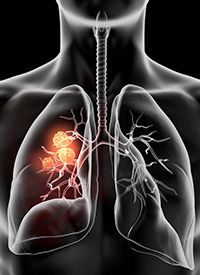Article
Pelcitoclax/Osimertinib Combo Shows Preliminary Effiacy in EGFR+ NSCLC
Author(s):
The combination of osimertinib plus pelcitoclax demonstrated an acceptable safety profile and preliminary efficacy at the recommended phase 2 dose in patients with EGFR-positive non–small cell lung cancer that is resistant to third-generation EGFR inhibitors or treatment naïve.

The combination of osimertinib (Tagrisoo) plus pelcitoclax (APG-1252) demonstrated an acceptable safety profile and preliminary efficacy at the recommended phase 2 dose in patients with EGFR-positive non–small cell lung cancer (NSCLC) that is resistant to third-generation EGFR inhibitors or treatment naïve, according to results of a phase 1b trial (NCT04001777) that were presented at the 2021 World Conference on Lung Cancer.
“Combination treatment with APG-1252 and osimertinib at the recommended phase 2 dose was safe and well tolerated,” Li Zhang, MD, of State Key Laboratory in South China Collaborative Innovation Center for Cancer Medicine, Sun Yat-sen University Cancer Center, Guangzhou, China, said during a presentation of the data. “Preliminary efficacy of this combination was observed in some patients with osimertinib resistance.”
Although osimertinib is a standard agent for the treatment of patients with EGFR-mutant NSCLC, resistant develops in most instances and necessitates additional treatment options for later-line disease management. Pelcitoclax is a novel dual BCL-2/BCL-xL inhibitor with evidence of antitumor activity, less platelet killing versus navitoclax, and potential synergism with osimertinib in preclinical models.
In the single-arm trial, the key objectives were safety and establishing the recommended phase 2 dose of pelcitoclax. In the dose-determination portion of the study, 7 patients received 240 mg of once-weekly intravenous pelcitoclax, and 6 patients were given a 160-mg weekly dose. All patients received daily oral osimertinib at 80 mg. In the expansion cohort, 20 patients with resistance to third-generation EGFR tyrosine kinase inhibitors who were also pretreated with platinum chemotherapy (Arm 1) and 23 patients with osimertinib-naïve NSCLC (Arm 2) were given the recommended phase 2 dose of 160 mg of weekly pelcitoclax plus 80 mg of daily osimertinib.
There was 1 dose-limiting event of grade-4 thrombocytopenia in the group receiving pelcitoclax at 240 mg (n = 7). In those receiving 160 mg (n = 49), there were no thrombocytopenia events of grade 3. Additionally, heightened levels of alanine aminotransferase (ALT; 46.9% vs 100.0%) and aspartate aminotransferase (AST; 51.0% vs 100.0%) were less frequent in those receiving the lower versus higher dose of pelcitoclax, respectively.
All-grade adverse events (AEs) occurring in the entire cohort (n = 56) were AST increased (87.5%), ALT increased (53.6%), platelet count decreased (32.1%), blood creatinine increased (23.2%), amylase increased (19.6%), white blood cell count decreased (19.6%), anemia (16.1%), and decreased appetite (12.5%). Grade 3 events occurring in the 160-mg group included AST increased (2.0%), ALT increased (2.0%), and white blood cell count decreased (2.0%). In the 240-mg group, grade 3 events were noted for AST (42.9%), ALT (28.6%), platelet count decreased (57.1%).
Preliminary efficacy showed an unconfirmed partial response (PR) rate of 15.0% and a confirmed PR rate of 5.0% in Arm 1, with corresponding rates of 59.1% and 36.4% in Arm 2. Stable disease was noted in 65.0% in Arm 1 and 36.4% in Arm 2, for disease control rates of 80.0% and 95.5%, respectively. Of note, no confirmed or unconfirmed responses were recorded for the 240-mg dose group in the dose-determination phase versus 1 unconfirmed partial response in the 160-mg group.
“Three patients with EGFR exon 20 insertion mutations in Arm 2 experienced tumor shrinkage. We are planning to open a new arm to enroll these patients separately,” Zhang said.
To conclude, Zhang added that there were no significant differences in the pharmacokinetic profiles of APG-1252 plus osimertinib when compared with each as monotherapy.
Reference
- Zhang L, Zhao H, Ma Y, et al. Phase 1b Study of Pelcitoclax (APG-1252) in Combination With Osimertinib in Patients With EGFR TKI-Resistant NSCLC. Presented at: 2021 World Conference on Lung Cancer; September 8-14, 2021. Virtual. Abstract MA02.06.








